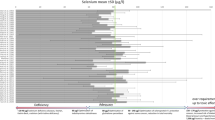Abstract
Objective: To investigate the effects of the Finnish nationwide selenium (Se) fertilization programme on the Se status of the population.
Design and subjects: Serum Se concentrations from 1985–1992 from 1568 healthy children and young adults in southwestern Finland were determined using direct electrothermal atomic absorption spectrometry.
Results: The mean concentration in young adults increased from 1.04 μmol/L in 1985 to 1.59 μmol/L in 1990. Children younger than 15 y had lower concentrations than adults, with an increase from 0.87 μmol/L in 1985 to 1.31 μmol/L in 1990. The younger the children, the lower the Se concentrations tended to be. At the age of about seven months no significant difference was noted between breast-fed and formula-fed infants. From 1991, when the amount of Se added to fertilizers was reduced and less foreign high-Se cereal was imported, the Se concentrations decreased in all age groups.
Conclusions: The nationwide Se supplementation programme has succeeded in elevating the Se intake and the serum Se concentrations in the Finnish population.
Sponsorship: Supported by the Juho Vainio Foundation and the Sigrid Juselius Foundation, Finland.
Similar content being viewed by others
Author information
Authors and Affiliations
Rights and permissions
About this article
Cite this article
Wang, WC., Mäkelä, AL., Näntö, V. et al. The serum selenium concentrations in children and young adults: a long-term study during the Finnish selenium fertilization programme. Eur J Clin Nutr 52, 529–535 (1998). https://doi.org/10.1038/sj.ejcn.1600602
Received:
Revised:
Accepted:
Published:
Issue Date:
DOI: https://doi.org/10.1038/sj.ejcn.1600602
- Springer Nature Limited
Keywords
This article is cited by
-
Assessment of selenium nutritional status of school-age children from rural areas of China in 2002 and 2012
European Journal of Clinical Nutrition (2016)
-
Selenium status and associated factors in a British National Diet and Nutrition Survey: young people aged 4–18 y
European Journal of Clinical Nutrition (2002)




